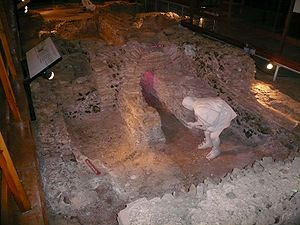
Welwyn Roman baths
Encyclopedia

Thermae
In ancient Rome, thermae and balnea were facilities for bathing...
are a small part of the Dicket Mead villa, a Roman
Ancient Rome
Ancient Rome was a thriving civilization that grew on the Italian Peninsula as early as the 8th century BC. Located along the Mediterranean Sea and centered on the city of Rome, it expanded to one of the largest empires in the ancient world....
ruin which was originally built in the 3rd century AD just north of modern-day Welwyn
Welwyn
Welwyn is a village and civil parish in Hertfordshire, England. The parish also includes the villages of Digswell and Oaklands. It is sometimes called Old Welwyn to distinguish it from the newer settlement of Welwyn Garden City, about a mile to the south.-History:Situated in the valley of the...
, Hertfordshire
Hertfordshire
Hertfordshire is a ceremonial and non-metropolitan county in the East region of England. The county town is Hertford.The county is one of the Home Counties and lies inland, bordered by Greater London , Buckinghamshire , Bedfordshire , Cambridgeshire and...
. The ruins were uncovered in 1960 by local archaeologist
Archaeology
Archaeology, or archeology , is the study of human society, primarily through the recovery and analysis of the material culture and environmental data that they have left behind, which includes artifacts, architecture, biofacts and cultural landscapes...
Tony Rook, and the baths were gradually uncovered over the following 10 years by excavation, and today are open to the public.
The full extent of the Dicket Mead villa was never fully excavated, but the baths were only one of at least four buildings in total. The complex was probably part of a farm, and may have also formed a country retreat for a wealthy merchant from London
London
London is the capital city of :England and the :United Kingdom, the largest metropolitan area in the United Kingdom, and the largest urban zone in the European Union by most measures. Located on the River Thames, London has been a major settlement for two millennia, its history going back to its...
or St. Albans. It has also been speculated that it might have been at least in part the equivalent of an hotel, lying as it does near the Roman roads from London to Chester.
Shortly after the excavation was completed, the Ministry of Transport
Department for Transport
In the United Kingdom, the Department for Transport is the government department responsible for the English transport network and a limited number of transport matters in Scotland, Wales and Northern Ireland which are not devolved...
announced the route of a new motorway, straight over the top of the excavation. Eventually arrangements were made whereby a steel vault would be built over the top of the baths with an access tunnel for the public. Once the vault was completed the A1(M) was built over the top of it, and the remains of the baths sit 9 meters below junction 6. Only about half of the original extent of the baths is now on display. Visible parts remaining include the hypocaust
Hypocaust
A hypocaust was an ancient Roman system of underfloor heating, used to heat houses with hot air. The word derives from the Ancient Greek hypo meaning "under" and caust-, meaning "burnt"...
, the tepidarium
Tepidarium
The tepidarium was the warm bathroom of the Roman baths heated by a hypocaust or underfloor heating system.The specialty of a tepidarium is the pleasant feeling of constant radiant heat which directly affects the human body from the walls and floor.There is an interesting example at Pompeii; this...
(warm room), caldarium
Caldarium
right|thumb|230px|Caldarium from the Roman Baths at [[Bath, England]]. The floor has been removed to reveal the empty space where the hot air flowed through to heat the floor....
(hot room) and the frigidarium
Frigidarium
A frigidarium is a large cold pool of Roman baths. It would be entered after the Caldarium and the Tepidarium, which were used to open the pores of the skin. The cold water would close the pores. There would be a small pool of cold water or sometimes a large Swimming pool...
(cold room) floor and cold bath, constructed from opus signinum
Opus signinum
Opus signinum is a building material occasionally used in ancient Rome. It is made of tiles broken up into very small pieces, mixed with mortar, and then beaten down with a rammer...
.
Today the baths are open to the public every day during Herts school holidays from 14:00 to 17:00 or (dusk if earlier), and outside school holiday periods at weekends and bank holidays 14:00 to 17:00 (or dusk if earlier)
Admission is free for children, and a small charge is made for adults.
Once the vault was finished, the bulk of the remaining parts of the Dicket Mead villa were covered over by the roadworks. Archaeological material from the site is stored at Mill Green Museum, part of Welwyn Hatfield Museum Service, which also operates the baths. This stored material can be inspected by contacting the curator.
External links
- Welwyn Roman Baths - official site at Welwyn Hatfield Borough Council
- Welwyn Museums website
- Herts interactive map
- Herts directory

